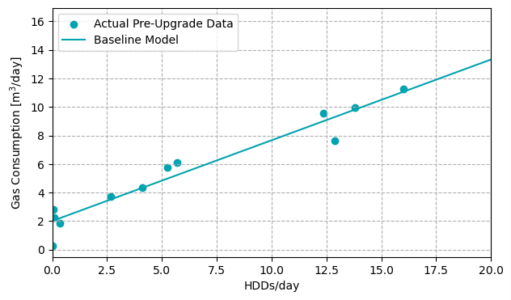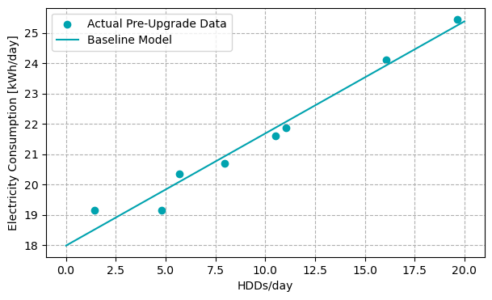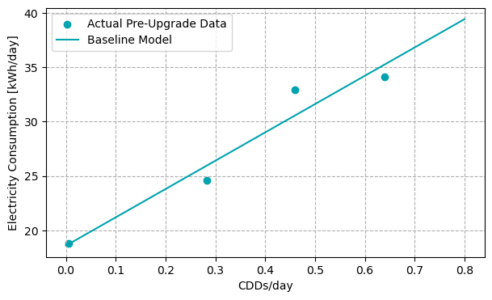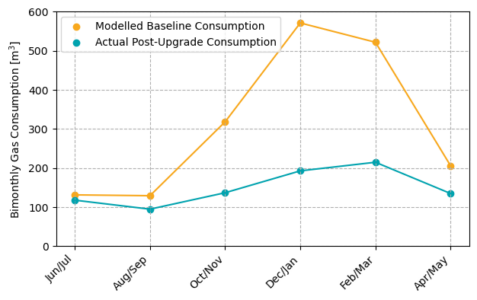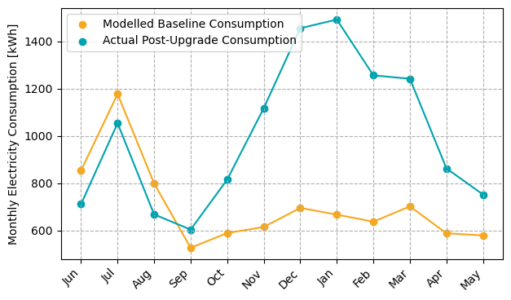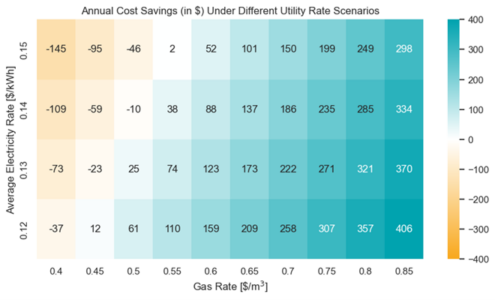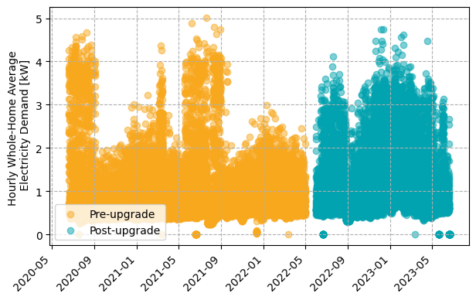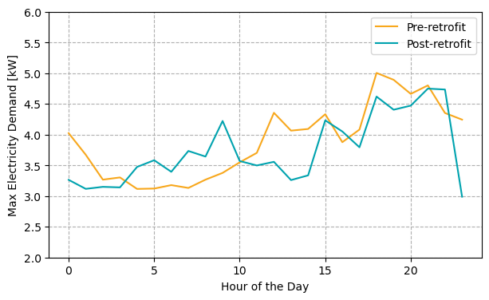
Home Heat Pump Case Study 7: Air-Source Heat Pump with an Existing Furnace
Published Online October 2023
Summary
If your home has an aging central A/C unit, there is an option that can provide you with much more value than simply replacing it with a new A/C unit. It is possible to save on utility bills, increase your comfort, make your home more eco-friendly, and not pay any more upfront than you would pay for traditional A/C. In this case study, we explore the experience of a Richmond Hill homeowner that installed an air-source heat pump (ASHP) to replace an aging A/C unit.
The ASHP was installed in combination with the existing furnace for the home. It provided all the cooling for the home and approximately 80% of the annual heating as well. The existing furnace was used as back-up for the ASHP when outdoor temperatures dropped below -10°C. The switching between ASHP and furnace was handled automatically by the thermostat. All-electric systems, without gas back-up, are available as well.
Analysis of pre- and post-installation utility bills estimated that gas consumption of the home reduced from 1,879 down to 893 m3 considering 1-year of operation after the installation. This is a reduction of 986 m3. The remaining consumption is largely due to the gas water heater.
Electricity consumption was estimated to have increased by 3,596 kWh. The net cost savings was estimated at $158 for the year, but could feasibly increase beyond $400 during the lifetime of the system due to planned increases in the natural gas rate from the Federal Carbon Charge. Additionally, carbon emissions were estimated to drop by between 1.1 and 1.7 tonnes CO2e for the year.
Interestingly, the peak power demand of the full home also decreased after installing the ASHP system. The peak power demand of the home formerly occurred during the summer and was due to the old (inefficient) A/C unit. The new peak is in winter but is smaller in magnitude than the previous summer peak. This is a relevant example for the broader discussion on home electrification and electricity grid constraints. In this home, space heating was mostly electrified without increasing the yearly peak demand of the home.
Starting in April 2023, the Enbridge HER+ Program now offers rebates up to $6,500 for ‘Coils Only’ ASHPs installed with an existing furnace. The rebate is also available for qualifying all-electric ASHPs and ASHPs installed with new furnaces as well. The change in April 2023 presents a significant new opportunity, especially for homeowners with newer furnaces that need an A/C replacement.
The homeowner discusses his experience with the ASHP.
The homeowner reports improved home comfort and lower bills. This case study shows that ASHPs provide significant value when compared to traditional systems. They are cost-effective to purchase, can reduce utility bills, are greener, and can improve comfort. Learn more about ASHPs at smarterhomeheating.ca.
What is an air-source heat pump?
An air-source heat pump (ASHP) can partly or completely offset a conventional home heating system that directly relies on fossil fuels like natural gas, propane, or oil. ASHPs are normally powered by electricity and provide heat to a home by extracting heat energy from cold outdoor air. Some cold-climate ASHPs operate in outdoor conditions as cold as -30°C. They also provide cooling. Because they “pump” heat, rather than just burn a fuel, ASHPs can be approximately 3x more efficient than furnaces or boilers. ASHPs can reduce carbon emissions and lifetime operating costs for homeowners. ASHPs look like A/C units and connect to the home in the same way.
Introduction
Numerous cities in Ontario, including those in the Greater Toronto and Hamilton Area (GTHA), have declared a Climate Emergency, signifying the urgency of addressing climate change by reducing carbon emissions. One of the biggest culprits behind carbon emissions in our region is the way we heat our homes and buildings [1] —primarily by burning natural gas.
This case study takes a closer look at a home in Richmond Hill where an aging air-conditioner was replaced with an air-source heat pump (ASHP). The ASHP provided all the cooling for the home, as well as most of the heating, with the gas furnace only being required as back-up in more extreme cold.
Through detailed analysis of the pre- and post- utility bills, this case study explores the impact of these changes on energy consumption, costs, and carbon emissions.
Site
The ASHP was installed in a detached home in Richmond Hill. The home was constructed in the late-1990s and the A/C unit was original to the home. The A/C unit was replaced by an ASHP in May 2022. The ASHP was used in conjunction with a newer existing furnace.
The ASHP-furnace system (called a hybrid system or a dual-fuel system) was configured such that the ASHP was the heat source for home whenever it had enough heating capacity, and the furnace was otherwise used. This meant that the ASHP was used to heat the home whenever the outdoor temperature was above approximately -10°C.
The switching between ASHP and furnace happened automatically via the thermostat. The homeowner determined the switching point through trial and error once the ASHP was installed by pushing the switching point to a lower and lower temperature until he observed that the ASHP had trouble maintaining the thermostat setpoint. The home also has an already existing gas water heater.
Upfront Costs
The ASHP model was an HMH72B24 from York. It was 2-ton side-discharge inverter-driven heat pump with an HSPF of 9 and a SEER of 17.5. It was installed with a new 2.5-ton evaporator coil. The invoice was shared by the homeowner and the total cost of the installation was $4,650 including HST.
Note that the heat pump cost and incentive landscape is rapidly changing. At the time of the installation, the Greener Homes Grant rebate program (now the Enbridge HER+ Program in Ontario) required that an ASHP be installed with a matched pair furnace or air handler. The ASHP installed by the homeowner in this case study did not qualify because it used an existing furnace to move air throughout the home, and it also did not meet efficiency requirements.
As of April 2023, there are “Coils Only” ASHP options within the approved equipment list that can be used with existing furnaces. Qualifying systems may receive up to $6,500 within the HER+ Program. A homeowner undergoing a similar retrofit today would likely utilize this rebate and select an ASHP from the approved equipment list.
The rebate being offered today is larger than the full upfront cost of this ASHP installation. It is important to note that equipment costs have increased since this installation, and also that costs will vary with the equipment, home, installer, and geographical region.
Considering these factors, the HER+ rebate would still cover much of the installed cost of a qualifying ASHP when it is used with an existing furnace. In many cases, this would allow an ASHP installation with an existing furnace to cost equal to, or less than, a basic entry-level A/C unit.
When it comes time to replace an air-conditioner, choosing a qualifying ASHP may not only be lower cost upfront than a like-for-like replacement, it may also be lower cost to operate than a basic A/C (owing to a better ASHP cooling efficiency), quieter than a basic A/C, and could dehumidify the home better while also making it more comfortable. These additional benefits are a result of the ASHP being driven by an inverter which can operate the system at partial load.
It could also drive utility cost savings in heating mode as well, greatly reducing the gas consumption of the furnace or even potentially eliminating the need for gas back-up heating entirely. Note that Natural Resources Canada cautions that there are special considerations when installing an ASHP with an existing furnace. [2]
Energy Savings
Natural gas and electricity bill consumption data were analyzed for 1 to 2 years before the upgrade, and 1 year after the ASHP upgrade. The pre-upgrade utility data was used to form a simple mathematical model describing how the home consumes energy with respect to changes in the outdoor temperature.
Within the models, the outdoor temperature was represented in terms of heating degree days (HDDs) and cooling degree days (CDDs). HDDs and CDDs are just a simple way of accounting for the variation in outdoor temperature within a given month. For the purposes of this case study, it is sufficient to know that more HDDs in a given month means that the month was colder, and more CDDs in summer months indicates hot outdoor temperatures.
Figure 1 shows the bimonthly gas consumption with respect to the average HDDs per day. Gas data was analyzed in 2-month increments because the gas meter is typically read every other month. The fact that the utility data falls closely along a line means that there is a simple mathematical relationship between the outdoor temperatures and the energy consumption of the home. This relationship was used to predict the baseline energy consumption of the home.
The baseline energy consumption is that which would have been expected without any upgrades, while also accounting for changes in weather. A baseline is needed as a point of comparison to estimate savings. Electricity consumption with respect to HDDs/day is shown in Figure 2. Figure 3 shows electricity consumption with respect CDDs/day for the cooling months and this captures the electricity consumption of the old air-conditioner.
Figure 1: The pre-upgrade gas bills were used to define a simple model of the home gas consumption with respect to weather conditions.
Figure 2: The pre-upgrade electricity bill data was used to define a simple mathematical model of home electricity consumption with respect to the weather conditions during months that had no cooling.
Figure 3: The pre-upgrade electricity bill data was used to define a simple mathematical model of home electricity consumption with respect to the weather conditions for months where there was cooling.
Based on discussions with the homeowner, it was determined that there were no other changes within the home that would have impacted utility consumption aside from the ASHP installation.
The calculated energy savings for 1-year after the ASHP installation is shown in Table 1. It was determined as the difference between the actual post-upgrade energy consumption and the modelled baseline energy consumption. The modelled baseline and actual post-upgrade energy consumption are shown in Figure 4 and 5. It was estimated that the ASHP is providing approximately 80% of the space heating energy required by the home. Note that energy savings will vary year-to-year with the weather. The full analysis containing all calculations and data is available in [3].
Table 1: Estimated electricity increase and gas reduction from utility bill analysis.
| Item | Value |
| Actual post-upgrade electricity consumption | 12,029 kWh |
| Modelled baseline electricity consumption | 8,433 kWh |
| Estimated electricity consumption increase | 3,596 kWh |
| Actual post-upgrade gas consumption | 893 m3 |
| Modelled baseline gas consumption | 1,879 m3 |
| Estimated gas consumption decrease | 986 m3 |
Figure 4: To determine gas savings, actual gas consumption (blue) was compared against the modelled baseline (orange) determined from the model in Figure 1.
Figure 5: To determine electricity savings, actual electricity consumption (blue) was compared against the modelled baseline (orange) determined from the models in Figure 2 and 3.
Annual Cost Savings
ASHPs are expected to last on the scale of 15 years before needing replacement (similarly to conventional A/C). Cost savings over the system lifetime cannot be predicted precisely, largely due to the volatility of gas rates. However, it’s possible to determine the savings over the one-year period that was analyzed in Figure 4 and 5 since the utility rates are known.
Gas bills included multiple line items and fees. Historical gas rates for Toronto are provided on the Ontario Energy Board website (OEB) [4]. Note that HST is not included for the OEB data and was added separately. In April 2022, the total marginal gas rate was 0.475 $/m3. In July, it changed to 0.594 $/m3. In October, it changed to 0.628 $/m3. In January, it changed to 0.640 $/m3. In April 2023, it reduced to 0.480 $/m3.Note that these rates neglect the fixed customer charge.
The OEB Bill Calculator [5] was used to estimate the marginal electricity rate including all fees and taxes but neglecting fixed costs. The estimated electricity use breakdown was 63% off-peak, 18% mid-peak, and 19% peak, resulting in a weighted time-of-use rate of 0.126 $/kWh.
Based on these rates, and the utility changes provided in Table 1, the net cost savings was calculated to be $158 for the 1-year period analyzed in Figure 4 and 5. Approximately $50 of the savings is estimated to be from the cooling months (and resulting from the higher cooling efficiency of the ASHP versus the previous A/C unit), with the remainder of the savings due to heating season operation.
Future rates are not known, but the Federal Carbon Charge is expected to add an additional 0.226 $/m3 to the cost of natural gas by 2030 [6] (approximately halfway through the system lifetime) above the gas rates used in the analysis. Further increases to this charge beyond 2030 are not known. Note that proceeds from the Federal Carbon Charge are paid back to taxpayers through the Climate Action Incentive.
As a simple sensitivity exercise, savings were recalculated with that additional expected charge of 0.226 $/m3 added to the gas rate with all else being the same. This would result in a net annual cost savings of $408. However, this is only one potential scenario. Other utility rate scenarios are considered in Figure 6.
Figure 6: Future utility rates are not known. Based on the utility savings calculated in Table 1, different utility rates were assumed with the aims of evaluating the impact on annual savings.
Carbon Emission Reductions
The carbon reductions over the system lifetime cannot be calculated precisely because the Ontario grid is in a state of transition and the future carbon content of grid electricity is uncertain. Even within the 1-year period post-upgrade that was considered in this analysis, there are different assumptions that could be made regarding the carbon content of grid electricity.
We used projections for 2023 from The Atmospheric Fund, which estimated and annual emission factor (AEF) of 70 g CO2e/kWh and a marginal emission factor (MEF) of 251 g CO2e/kWh. [7] The AEF and MEF represent two different approaches for tabulating carbon emissions, but it is not essential to understand how they are different for this case study. Based on these assumptions, the carbon emissions reduction was estimated to be either 1.1 or 1.7 tonnes CO2e for the 1-year post-upgrade period that was analyzed.
Electricity Demand
The homeowner provided hourly electricity data for the home that had been obtained from their electrical utility portal. This data was used to look at the maximum electricity demand of the whole home before and after the ASHP installation (Figure 7). This is of interest for ASHP deployment generally because the projected societal shift to electricity for heating and transportation is expected to increase the strain on the electricity grid.
Figure 7: The peak of the hourly average electricity demand for the home was slightly reduced after the ASHP installation.
In this home, the maximum power draw from the electricity grid actually decreased after the ASHP was installed. Pre-upgrade, the annual peak power draw happened in the summertime and was result of the previous (inefficient) A/C unit. Post-upgrade, the summertime peak was reduced because of the higher ASHP cooling efficiency. The maximum power draw for the year shifted to the heating season. However, it was still lower than the previous peak that happened during the summer.
The maximum power draw of the home for each hour of the day for both pre- and post-ASHP installation are shown in Figure 8. Post-retrofit, the home had lower demand overnight and midday, had greater demand in the morning, and slightly lower demand in the evening.
Figure 8: The maximum power draw for different hours of the day was evaluated for 1 year (or more) pre- and post-ASHP installation. The peak power draw was slightly reduced post-installation.
The broadscale grid-integration of ASHPs is a complex issue that is beyond the scope of this case study. However, it is nonetheless important to note for broader decision-making that, in some cases, it is possible to electrify a substantial portion of a home’s space heating load and still overall decrease the peak power demand for the year.
Conclusion
- In Summary: The ASHP proved to be a valuable addition to this newer detached home, replacing an aging A/C unit. It not only handled all the cooling needs but also provided the majority of the heating requirements. The homeowner was pleased with the cost savings, the eco-friendliness of the system, and the overall experience.
- Save with Rebates: Whether you’re looking to replace your entire heating and cooling system or just your A/C unit, your Ontario home may be eligible for substantial rebates through programs like the Enbridge HER+. In many cases, installing a new ASHP alongside an existing furnace can be cost-competitive with a basic A/C unit, or lower cost.
- More for Less: The ASHP featured in this case study offers more value than a traditional A/C unit because it functions as both a heating and cooling system. It not only lowered utility bills year-round but also operates more quietly in the summertime, maintains more stable indoor temperatures, and improves indoor humidity levels. Furthermore, it’s a much greener choice for homeowners.
- Sizing is Key: To maximize your savings, it’s crucial to choose a right-sized ASHP that is tailored to your heating needs. [8] In this case study, the ASHP was estimated to meet over 75% of the home’s annual heating demand. Homeowners should engage with HVAC professionals to explore options for even greater savings and also, if desired, explore the possibility of all-electric solutions.
- Want to Learn More about ASHPs? If you’re interested in discovering how an ASHP could benefit your home, we invite you to visit smarterhomeheating.ca. There, you can find additional information, resources, and connect with experts that can answer further questions to help you achieve a more efficient and comfortable home.
About Us
For more than 15 years, the Sustainable Technologies Evaluation Program (STEP) has been a collaborative non-profit research initiative within the Toronto and Region Conservation Authority (TRCA). Among other priorities, STEP partners with government, utilities, non-profits, academic institutions, and private companies, to pilot and evaluate emerging low-carbon technologies for buildings with the aim of providing real-world data, analysis, tools, and outreach that promotes effective technological solutions for climate change mitigation.
Note
This communication has been prepared by the Sustainable Technologies Evaluation Program (STEP). STEP gratefully acknowledges the contributions of homeowner Rick Wu. The contents of this report do not necessarily represent the policies of supporting agencies. Mention of trade names, vendors, and commercial products does not constitute an endorsement of those products or services.
Primary support for the creation of this document provided by The Atmospheric Fund (TAF) and the City of Toronto. Base support for STEP research is provided by York Region and the Region of Peel.

If you are interested in getting involved through any of our engagement opportunities, please contact us at:
STEP@trca.ca | twitter.com/STEPLivingCity
References and Endnotes
[1] The Atmospheric Fund. 2019 – 2020: Carbon Emissions Inventory for the Greater Toronto and Hamilton Area. 2021. https://taf.ca/custom/uploads/2021/12/TAF_Carbon-emissions-inventory-GTHA_2021.pdf
[2] The Natural Resources Canada website offers this guidance for using ASHPs with existing furnace (https://natural-resources.canada.ca/energy-efficiency/homes/canada-greener-homes-grant/start-your-energy-efficient-retrofits/plan-document-and-complete-your-home-retrofits/eligible-grants-for-my-home-retrofit/23504#s5): For a “Coils Only” heat pump system, steps must be taken to ensure their heating and cooling performance. Homeowners must work with their mechanical system contractors to understand the implications of operating this system with their existing furnace and thermostat. This is important as custom combinations of “Coils Only”, without pairing it with appropriate furnaces and controls, can limit the benefits of the heat pump system, potentially reducing the energy efficiency and home comfort. When considering “Coils Only“ products, to ensure optimum performance and savings, it is strongly recommended that:
- the furnace has a blower with an Electronically Commutated Motor (ECM) or variable speed
- the furnace controls allow the thermostat to work properly with the heat pump system
- the thermostat must be compatible with both the heat pump and the furnace
- the rated airflow of the furnace and the heat pump are similar
[3] Calculations for this case study are available at: https://github.com/SustainableTechnologies/CaseStudy7
[4] Ontario Energy Board Website. Historical Natural Gas Rates. https://www.oeb.ca/consumer-information-and-protection/natural-gas-rates/historical-natural-gas-rates
[5] Ontario Energy Board Website. Bill Calculator. https://www.oeb.ca/consumer-information-and-protection/bill-calculator
[6] Enbridge’s website lays out the implications of the Federal Carbon Charge on gas rates. The website also states “The federal government has indicated that direct proceeds from the carbon pricing program will be returned to Ontario residents through a climate action incentive (CAI) payment. As of July 2022, the federal government began delivering CAI payments on a quarterly basis, as four equal payments delivered at the beginning of each quarter. In order to receive a CAI payment, individuals need to file an annual tax return. For an average Ontario family of four, the annual total of the quarterly CAI payments for 2023 is expected to be $976.” https://www.enbridgegas.com/en/residential/my-account/rates/federal-carbon-charge#:~:text=As%20part%20of%20the%20federal,charge%20increases%20annually%20each%20April.
[7] The Atmospheric Fund. A Clearer View of Ontario’s Emissions. 2021 Edition. https://taf.ca/custom/uploads/2021/11/20211116_TAF_Emissions-Factors-Guidelines.pdf
[8] Natural Resources Canada’s ASHP Heat Pump Sizing and Selection Toolkit can help achieve a right-sized system. See: https://natural-resources.canada.ca/maps-tools-and-publications/tools/modelling-tools/toolkit-for-air-source-heat-pump-sizing-and-selection/23558
General Note: The content of the case study was edited with the aid of ChatGPT.

